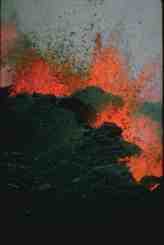 |
Over the last several million years the Hawaiian Islands have been built of successive
lava flows. They are the most recent additions in a long line of volcanoes that extends
up the intersection ofthe Aleutian Island chain with the Kamchatka peninsula. This
set includes very colorful imagesof lava fountains, lakes, cascades, flows, spatter
and lava entry to the sea from eruptionsoccurring over the last 30 years. Most of
these volcanoes are no longer visible above the sea surface. These islands and sea
mounts formed as the Pacific plate moved over a hot spot in Earth's mantle. The amount
of lava that has erupted here is difficult to comprehend. Mauna Loa, on the Island
of Hawaii (Big Island) is the largest volcanic structure in the world with a volume
estimated at 42,000 km3. It rises from the ocean floor, 5,000 m below sea level, to
a height above sea level of 4,172 meters. In addition to eruptions at the summit,
Hawaiian volcanoes have flank eruptions with lavaflowing several kilometers from the
vent. The height of such volcanic structures (known as shield volcanoes) increases
only slightly while they continually grow in width. Hawaii's usually non-explosive
eruptions are characterized by the relatively quiet outpouring of lava known as effusive
eruptions. High temperature, a low gas content, and exceptionally fluid lava are typical
of these eruptions. The high fluidity of Hawaiian lava comes from its basaltic composition.
They are contrasted to the more viscous dacite erupted explosively at Mount Saint
Helens in 1980. Hawaiian eruptions usually start with lava issuing vertically from
a central vent or a fissure in a rhythmic jet-like eruption, called a lava fountain.
The lava fountains vary widely in form, size and duration depending on the shape of
the vent, volume of lava, and other conditions. Fountains spouting from a series of
nearly continuous fissures are called curtains of fire. As the eruption proceeds the
lava fountain activity is confined to a single vent or opening. The lava may form
lava lakes of fluid rock in summit craters or in pit craters on the flanks of the
volcanoes. If the lava lake forms around an active vent, the crust breaks up in response
to circulation and sloshing of the molten lavabeneath. Lava falling from fountains
and flowing from vents often forms glowing lava streams or lava flows. During some
Mauna Loa eruptions flows rushed down the steep slopes at 58 km per hour. As the eruption
continues, the lava solidifies along the edges of the flow building levees or ramparts
that allow the level of the lava to be raised. If the roof of the channel hardens
and forms a solid crust the molten lava may continue to flow within what has become
a lava tube. Lava tubes generally have arched roofs but their floors may be flat,
formed by the surface of the last liquid lava to move through them. The walls of such
tubes become thermal insulators allowing the lava to flow greater distances from the
vent. Lava streams that plunge over cliffs or the steep walls of craters form lava
cascades or lava falls. There are two main types of lava flows: pahoehoe, and aa.
The Hawaiian names refer to the surface character of the lava. Many flows consist
ofpahoehoe upstream and change to aa downstream. However, aa flows do not change into
pahoehoe. The type of lava is determined by the initial gascontent of the lava, the
changes in lava viscosity and the rate of deformation (shear strain of the lava during
flow and cooling). Pahoehoe has a smooth surface. In some areas it is wrinkled and
twisted resembling folds in heavy cloth. This appearance results from the dragging
and twisting of the thin, hot, still-plastic crust of the flow by movement of the
liquid lava underneath. The surfaces of most pahoehoeflows are rolling or undulating.
One can walk across a moving flow, and although the crust may bend, it does not break.
The crust of a lava flow is a poor conductor of heat so the part of the flow beneath
the crust may remain hot and liquid for long periods. Shrinkage on cooling and distortion
by the movement of the liquid beneath it causes fractures in the crust. The interior
of thick flows may remain liquid for weeks, months, or year. A is characterized by
a rough, rubbled surface. The layer of angular jagged fragments is known as clinker.
The streams of molten lava that feedaa flows usually do not "freeze over" like those
of pahoehoe and therefore seldom form lava tubes. Close to the vent the surface of
the aa stream maybe smooth orange-hot lava that quickly becomes covered with a lead-gray
glassy skin. As the crust is disrupted by movement of the flow beneath it the characteristic
spiny surface begins to appear. When lava flows reach a shore line and encounter the
ocean, littoral (coastal) explosions can occur. A lava flow within a body of water
formspillow lava. Each pillow is enclosed in a thin skin of glass. The pillows accumulate
by settling one on top of another while they are stillsufficiently plastic to mold
themselves to the underlying surface. Evidence of rapid chilling and close association
with water deposited sediments indicates clearly that pillow lavas were formed either
beneath water or by extrusion over very wet swampy surfaces. The Islands of Hawaii
provide an excellent location for the study of the many and varied forms of lava. |